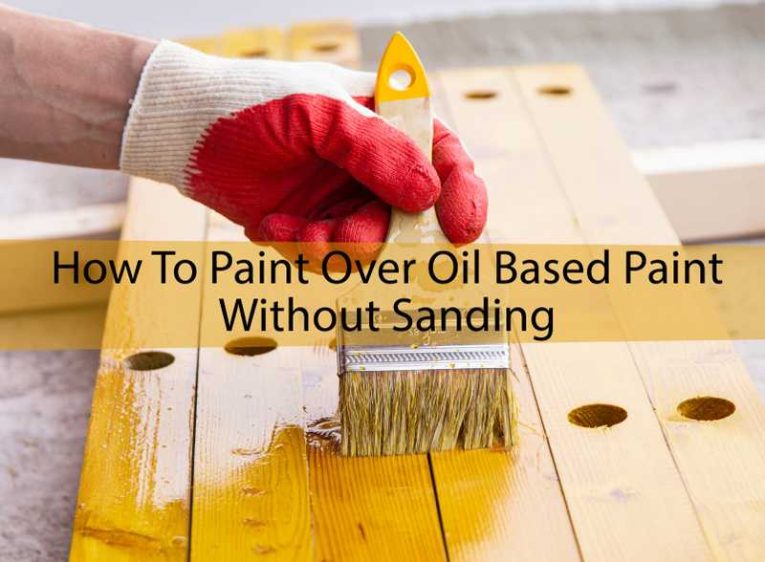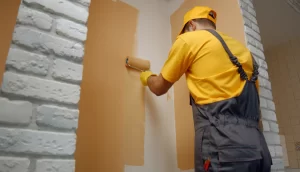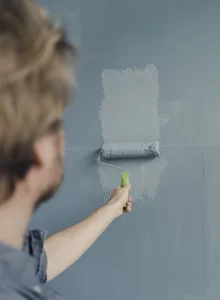Painting over oil-based paint can be a daunting task. The thought of all that sanding is enough to make anyone want to procrastinate. But there is a way to avoid all the sanding and still get a beautiful, smooth finish on your walls and it doesn’t even require any special skills or products.
Sanding is time-consuming, messy, and can be difficult to do correctly. If you’re painting over oil-based paint and don’t want to sand, there’s a way to do it without all the hassle. With the proper preparation and primer, you can paint over oil-based paint without sanding. So let’s learn how to paint over oil based paint without sanding.
How to paint over oil-based paint without sanding?
1. Start with a clean surface:
The first step is to make sure your surface is clean. Oil-based paint can be challenging to remove, so it’s important to start with a clean slate. If your walls are dirty, wash them with a mild detergent and water. Once they’re clean, allow them to dry completely before moving on to the next step.
2. Apply a primer:
The next step is to apply a primer. This will help the paint adhere to the surface and create a smooth finish. When choosing a primer, make sure it’s compatible with the paint you’re using. For oil-based paint, an oil-based primer is best. It’s also essential to choose a primer designed for use on walls.
3. Choose your paint carefully:
Once you’ve chosen a primer, it’s time to select your paint. When painting over oil-based paint, it’s best to use oil-based paint. This will ensure that the paint adheres properly and creates a smooth finish.
4. Paint your walls:
Now that you’ve prepared the surface and selected your paint, it’s time to start painting. Begin by painting the trim first, then move on to the walls. Use a brush or roller to apply the paint evenly, working in small sections.
5. Allow the paint to dry:
After you’ve finished painting, allow the paint to dry completely before moving on to the next step. This usually takes about 24 hours.
6. Apply a top coat:
Once the paint has dried, it’s time to apply a topcoat. This will help protect the paint and create a beautiful, smooth finish. Choose a topcoat that’s compatible with the paint you’re using. For oil paint, an oil-based topcoat is best.
7. Enjoy your newly painted walls:
Once the top coat has dried, you’re finished! You can now enjoy your newly painted walls.
The Pros And Cons Of Painting Over Oil Based Paint:
- It’s a quick and easy way to give your walls a new look, and it doesn’t require any special skills or products. Painting over oil-based paint can provide a smooth, beautiful finish when done correctly.
- It’s a great way to cover up imperfections on the surface below. If your walls have cracks or other damage, painting over them can help hide these imperfections.
- It’s a cost-effective way to update your home. Painting is typically cheaper than other methods of wall updates, such as wallpapering or tile.
- You have a wide range of color options. Paint comes in thousands of different colors, so you’re sure to find the perfect shade for your home.
- It’s relatively low-maintenance. Once the paint is dry, it doesn’t require much upkeep.
- The new paint may not adhere properly to the surface below. If the surface isn’t adequately prepared, the new paint can start to peel or chip.
- It can be challenging to remove oil paint, so you may need to hire a professional if you want to go back to the original look.
- You may need to sand the surface before painting, which can be time-consuming and messy.
- If not done correctly, painting over this kind of paint can result in an uneven, patchy finish.
How to choose the right type of paint for painting over oil-based paint?

First, you’ll need to select a paint appropriate for the surface you’re painting. For example, if you’re painting over oil-based paint on metal, you’ll want to use oil-based paint designed for metal surfaces.
Second, it’s important to know that oil-based paints take longer to dry than other types of paint. This means that you’ll need to be patient and give the paint plenty of time to dry before adding a new layer or attempting to paint it.
Third, when painting over oil paint, it’s essential to use a primer. This will help the new paint adhere to the surface and create a smooth, even finish.
Finally, always test your paint on a small area before painting the entire surface. This will help you to gauge the coverage and color of the paint and to make sure that it is compatible with the oil-based paint.
Can You Oil-Based Paint Over Oil-Based Paint?

Start by sanding the surface to create a smooth base. Then, apply a primer designed for use on oil-based paint. Once the primer is dry, you can add a new layer of paint.
Painting over oil-based paint without sanding is possible with the proper preparation. By starting with a clean, smooth surface and using a primer, you can achieve a beautiful finish without any sanding.
Can You Water-Based Paint Over Oil-Based Paint?
If the previous layer of paint is still in good condition, you may be able to simply paint over it with a new layer of water-based paint. Before you begin, thoroughly clean the surface to remove any dirt or grease. If the old paint is in poor condition, you’ll need to sand it or prime it before painting.
You can apply water-based paint over oil-based paint as long as the surface is adequately prepared. Start by sanding or priming the surface, then apply a new layer of paint.
Applying a new layer of paint over an existing layer of oil-based paint is generally not recommended. However, if you decide to do this, it’s essential to take the necessary precautions to ensure that the new paint adheres properly.
First, sand the surface of the old paint to create a rough texture. This will help the new paint bond with the old layer. Next, clean the surface with a degreaser or trisodium phosphate solution to remove any residual oils.
Finally, apply a primer designed for use on oil-based paints before painting with your desired water-based paint.
Why Applying Latex Directly to Oil Paint is a Bad Idea?

However, oil-based paint can be tricky to work with. One of the most significant issues is that it doesn’t always play well with other types of paint. For example, if you’re painting a room previously painted with latex paint, you may be tempted to simply apply a new coat of latex paint directly over the old paint job.
While it’s possible to do this, it’s not always the best idea. Here’s why applying latex paint directly to oil paint can be a bad idea:
- The two types of paint don’t adhere well to each other.
- Oil-based paint takes longer to dry than latex paint.
- Applying latex paint over oil paint can cause bubbling and flaking.
- It’s difficult to achieve a smooth, even finish when painting over oil paint with latex.
If you’re planning to paint a room in your home, and the previous paint job is oil-based, it’s best to remove the old dried paint before applying new latex paint. This extra step may take a bit more time, but it will result in a better-looking finish that will last longer.
FAQs About Painting Over Oil Based Paint Without Sanding:
What kind of paint will stick to oil-based paint?
The best paint to use over oil-based paint is latex or water-based acrylic paint. These paints are specially formulated to adhere well to previously painted surfaces, even those treated with oil-based paint.
What happens if you paint water-based paint over oil-based paint?
If you paint water-based paint over oil-based paint, the new paint will not adhere correctly. The old paint will eventually peel, and the new paint will begin to chip and flake off. To avoid this issue, you must sand the surface before painting over oil-based paint with water-based paint.
Can I paint oil-based paint over oil-based paint without a primer?
You cannot paint oil-based paint over oil-based paint without a primer. A primer provides a smooth surface for the new paint to adhere to and also helps to prevent peeling and flaking.
What primer do I use to cover oil-based paint?
You can use a water-based or latex primer to cover oil-based paint. Be sure to choose a specially formulated primer for use over oil paint, such as Zinsser Bulls Eye 1-2-3 Primer.
Can I paint over an old oil painting?
Yes, you can paint over an old oil painting. However, you will need to prepare the surface first by cleaning it and applying a primer. Once the primer is dry, you can then paint over the old oil painting with a new layer of oil-based or latex paint.
Can you use water-based paint over oil based undercoat?
No, you cannot use water-based paint over oil based undercoat. The new paint will not adhere properly and will likely peel and flake off.
What paint can I use over oil-based paint?
You can use either latex or oil-based paint over oil-based paint, as long as you follow a few basic steps. If you’re using latex paint, you’ll need to prime the surface first. This will help ensure that the new paint adheres properly and doesn’t peel off.
Painting over oil-based paint with acrylic?
Yes, you can paint over oil-based paint with acrylic paint. Acrylic paint will adhere to oil paint and provide a long-lasting finish.
How to tell if the paint is oil-based?
Labels, if present, are the best way to determine if the paint is oil-based. If there is no label, you can try to remove a small amount of paint from the can with a putty knife. Check if the paint comes off easily, it is probably water-based. If it takes some effort to remove, it is most likely oil-based.
Conclusion:
In conclusion, painting over oil-based paint without sanding is possible. However, there are a few things you need to consider before starting the project. Ensure the surface is clean, dry, and free of grease or dirt. Also, choose the right type of paint for the job.
If you’re painting over a dark color, use a white primer first to help brighten up the space. With a little bit of prep work, you can easily paint over oil-based paint and achieve great results.




2 thoughts on “How To Paint Over Oil Based Paint Without Sanding?”